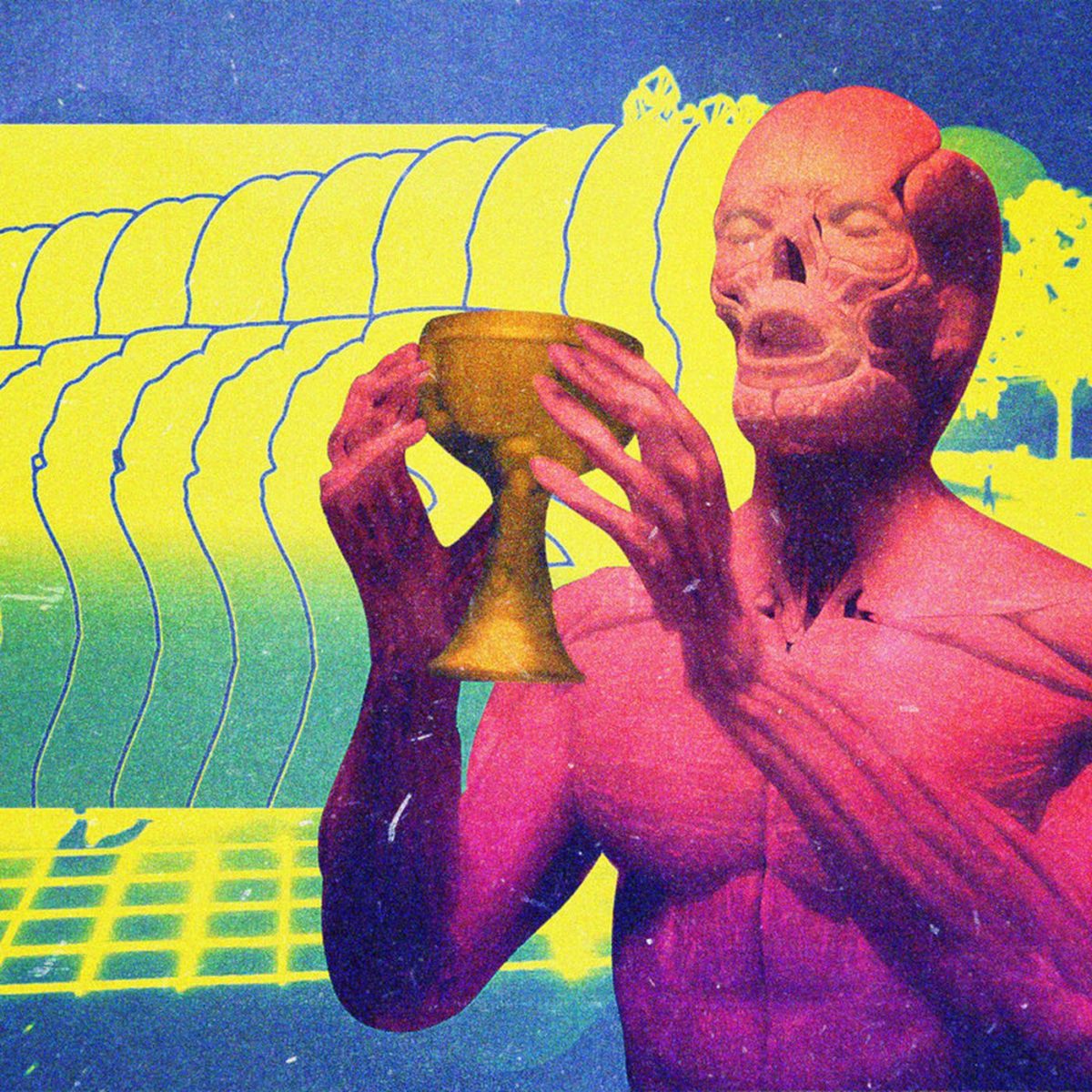
Rodney Ascher’s documentaries are studies of the knotty, sometimes terrifying theories born in the human intellect. His first feature, Room 237, depicted four obsession-level fan theories around The Shining, including one that involves Stanley Kubrick’s supposed involvement in faking the 1969 moon landing. Ascher’s second film, The Nightmare graphically depicts the phenomenon of sleep paralysis: a very real but little understood source of hallucinations, belief systems, and supernatural experiences around the world. (Simply thinking about the topic is believed to stimulate the phenomenon.) His newest feature, A Glitch in The Matrix, unfurls the contemporary concept of simulation theory, which was coined by the philosopher Nick Bostrom, popularized with films like The Matrix, and gilded with Elon Musk’s confident assertion that we are all living in a simulation. Like horror films, Ascher’s trilogy of films are driven by narrative engines of mystery and dread. He understands that conspiracy theories and pseudo-knowledge can hypnotize viewers into a dream and lead them into places they would otherwise refuse to go. For this interview, I communed with Ascher via email, over several days. This was our second interview: we also spoke, years ago, for The Believer podcast, The Organist about a wonderful, bygone piece of musical equipment called The Optigan.
—Ross Simonini
THE BELIEVER: What is your definition of simulation theory?
RODNEY ASCHER: It’s the idea that we’re all living in some sort of artificial world, specifically a digitally, computer created one and that the real, analogue world is “out there” someplace; in fact we could be in a simulation within a simulation (within a simulation within a simulation).
The idea is certainly familiar to anyone who saw The Matrix (or eXistenZ, the 13th Floor, World on a Wire, Mindwarp, Total Recall, or Black Mirror: Bandersnatch) but it’s caught on as a non-fiction idea in recent years, too, one milestone being the publication of Oxford professor Nick Bostrom’s 2003 Paper “Are You Living in a Simulation?”

BLVR: The film discusses Philip K. Dick’s central role in developing the theory. Is there a broader literary tradition of this idea?
RA: PKD started writing stories about alternate realities in the 50s, notably with early books like Eye in the Sky (1957) and Time Out of Joint (1958) continuing to explore the idea throughout his career. Other notable entries in the genre include Jonathan Lethem’s Amnesia Moon (1995), and Kurt Vonnegut Jr’s Breakfast of Champions, sort of (1973). Depending on how strictly you define “simulated worlds” it might include Wizard of Oz and Alice in Wonderland, too.
The fact that Dick imagined a world created by computers in a time when computers spun magnetic tapes on reels and spat out punch cards blows my mind. From today’s vantage point which includes VR-ready 3D networked games with accurate physics and lighting, it feels like you can see the simulation from here, but back then?
BLVR: Do you find the theory tenable?
RA: The plausibility of the science of it has been taken seriously by people exponentially smarter than me (Musk, DeGrasse-Tyson, Bostrom) so if I were to try to argue against it, I wouldn’t use physics or I’d be almost immediately out of my depth.
BLVR: Do you believe it?
RA: The boring answer is “probably not” though I’m not ruling anything out. I’m pretty agnostic about a lot of things but very interested nonetheless. Like Agent Mulder, “I want to believe.”
But I get that living through what feels like unbelievable history makes it all the easier to feel that in some way all of this isn’t real, right? I see countless jokes on Twitter to that effect everyday and I’ve heard from many people who remember seeing The Matrix and saying “of course that’s what’s going on.” I can see why people would rather believe that we’re living in a video game or science experiment or museum exhibit of some kind rather than in, say, a completely random series of chemical reactions. It’s always reassuring to know that someone’s in charge, even if their motives are unknown.
BLVR: Is it impossible to dispute simulation theory, considering how all-encompassing it is?
RA: No. Even Nick Bostrom only suggests it’s one of multiple possibilities and I would imagine the theory still subject to Sagan’s notion that extraordinary claims require extraordinary evidence. (Though a quick Googling of that phrase tells me it’s been the subject of some pretty intense scrutiny itself so around we go again.)
BLVR: Is this theory valuable to humans in any way?
RA: That’s harder to say (depending on your values). If simulation theory happens to be true, then I suppose value is beside the point, we just need to deal with it. As a hypothesis that’s rapidly gaining traction, it’s certainly a powerful frame to look at the world, and that’s rewarding in its way, even if just for long, stoney dorm room conversations (which I happen to treasure).
The film talks a little (maybe more than a little) about some of the dangers of living in a world you don’t consider to be fully real but if it inspires you to think a little harder about how you’re going to live the only life you know you have for sure, that feels pretty valuable to me.
BLVR: Simulation theory is not so different from all sorts of religious perspectives, like the Hindu notion of Maya, the illusion of reality.
RA: That’s true and right at the top of the film Paul Gude gets at something like that, suggesting that people can only use familiar concepts to describe new ideas. He was talking about a teacher’s metaphor for how the brain works but I was reminded of something I think comes from an old episode of Project UFO or In Search Of… the idea that when aliens visited us in Medieval Times, artists depicted them as arriving in flying wooden sailboats, dropping anchors to the ground as they came in for a landing because the sleek metal spaceships of contemporary sci-fi were too foreign an idea for them to even register. I saw that when I was eleven or so and the idea burnt into my synapses.
Erik Davis also went to lengths to describe simulation theory’s similarity to ancient religious ideas, just as you point out, and I think that maybe Arthur C. Clarke’s adage “Any sufficiently advanced technology is indistinguishable from magic” bridges the gulf between Maya and The Matrix. For me, the idea that this world is a digital creation and not a mystical, supernatural one, changes both the nature of our creators (they may well be ordinary people like us, only ones with access to highly advanced technology) and also the purpose of our world’s creation.
BLVR: Do simulation theorists have any particular take on the pandemic?
RA: Two provocative (though mutually excIusive ) ideas I’ve heard are A) these things are evidence of something going terribly wrong in this simulation. Or, B) these things are the whole point of it. Imagine a scenario where there’s a pandemic out in the real world and they create a thousand simulations with slightly tweaked variables to see if any of them find a solution that they could use. I’m not feeling that ours is the one that performed the best.
Interestingly there was also a pandemic in World of Warcraft, (one of the largest multiplayer networked games) called the Corrupted Blood Plague in which an energy-sapping disease managed to accidentally explode throughout their world (due to asymptomatic carriers) and devastate the population. Players themselves split into those trying to stop it and many who spread it on purpose. Sadly, the players were not able to contain it on their own and the programmers had to step in. Apparently it’s been studied by epidemiologists as a model for contagions.
As I think about it, I’m remembering one other idea someone had that lockdown was a good opportunity for the creators to alter the game board without any of us noticing.

BLVR: Do you find that simulation theory tends to overlap with any political perspectives?
RA: Emily Pothast made a pretty good case, riffing off Plato’s Cave, that we all carry within us a model of the world constructed at least in part from our media diets. Considering the fact that at least some media suffers not only from unintentional signal loss or accidental errors, but also intentional biases and distortions, then people exposed to radically different information sources could genuinely live in different worlds. That’s a pretty difficult obstacle for reaching across the aisle. (That’s, of course assuming I’m not completely misunderstanding the point she was making.)
But if you’re asking “is the simulation theory more popular with liberals, conservatives, libertarians, socialists or fascists?” I have no idea, but in my non-scientific sample it does seem to be more popular with men than women for whatever that’s worth.
BLVR: Did you find any instances where simulation theory allows people to live happier, more liberated lives?
RA: I can’t speak to his overall state of happiness and how that’s changed over the years but Elon Musk sure seems to be thriving.
BLVR: What’s the most extreme version of simulation theory you’ve come across?
RA: Paul mentioned a scenario that really haunted me, “what if every person in the world throughout history were, in fact, the same person or omnipotent being reincarnated endlessly into a world he/she/they created in order to kill time in the face of an eternity they’re doomed to spend truly alone?”
BLVR: A central idea in your work is hyperstition, the notion that an artwork can change the beliefs of the people who experience it: The Shining, The Matrix and even your film, The Nightmare, is said to give people the experience of sleep paralysis. Does this suggest a nefarious power of art?
RA: Although I take the power of art and film and music to inspire, connect, and change people seriously, one of the things I like best about it (other than the in the moment visceral experience) is how it gives us common frames of reference. I’d be one of the last people to advocate the censoring of “dangerous” artworks, even if the last four years have softened my free-speech fundamentalism a little. I remember The Warriors and Taxi Driver, Ozzy, and Judas Priest being accused of inciting violence growing up but none of them have a bodycount that can compare to the Bible or other religious texts.
That said, there’s a special place in my heart for fictitious stories of weaponized art whether we’re talking the Silver Shamrock masks in Halloween III, the brain-tumor causing signal embedded in the Videodrome broadcasts, or the creatures who pierce the veil between the silver screen and audience in Lamberto Bava’s Demons. I like the idea that art can be something like a wild animal, beautiful, but don’t forget it has claws.
BLVR: Are there other artworks that have served this transformative function for you?
RA: Probably not what you’re looking for, but as a chubby teenager Gandhi impressed upon me how easy it was to lose weight by fasting.
About a decade later I had to retreat to the bathroom and explode into tears after being overwhelmed by a large-scale Andy Warhol retrospective. His work still holds a huge influence on me.
BLVR: Your three features are all studies of marginal theories. These kinds of thinking are seen as increasingly dangerous in the time of QAnon, and your film suggests a similar danger. Are you making these films to diffuse the potency of these ideas?
RA: Putting it like that makes me wish it were so but I’d be disingenuous if I said I made all three to debunk “conspiracy theory” itself.
In each case, my interest in the subject came well before I landed on a theme and I always prefer to ask questions than to offer messages. 237 was simply inspired by my friend Tim and my love of Kubrick and our fascination with the interpretations that sprung up around the Shining (and the way they made a film with a reputation for being very scary even more so). As it came together I felt that what 237 was really doing was allowing the audience to rewatch the same piece of media through the eyes of multiple observers, each using very different toolkits, and The Shining just happened to be the example under the microscope. For better or worse, conspiracy theory is one frame people have been using more and more as they look at everything these days. Personally, I think 237 asks the question, “Who decides what a work of art means? The creator, critics, academics, or the individual viewer?” Of course, if different people see different movies differently and if there’s anything to The Death of the Author, my own interpretation of 237 is only one of many as well.
And if The Nightmare was a psychology paper, it was almost entirely focused on the case studies, the part I typically find most interesting. I went into it with an interest in the subject (having experienced it myself) but no preconceived notions about conclusions I would draw. Ultimately I kept the question of whether the things people saw came from “inside” or “outside” as unresolved for the audience as it was for the subjects.
Glitch is similar in a lot of ways, only many of the subjects spoke to the dangers of this kind of radical doubt and cutting it in 2019 or 2020, I was all too glad to include that point of view. Not that it’s neatly tied in a bow because that’s not true to everyone’s experiences. I’m a heavy-handed filmmaker in some of the choices I make but one thing I try to be conscientious of is accurately reflecting the experiences and feelings of the people I feature in these things. Even, maybe especially, when what they feel is different from what I imagine the audience might think (or whatever I do.)
BLVR: Do you have any forecasts on how simulation theory will play out in the future?
RA: There’s talk from multiple people in the film that it could form the basis of a new religion in the future and I could totally see that; we might just be one charismatic guru away from it happening. There’s also been chatter of different attempts to prove or debunk it scientifically. I’ll be anxious to see where that goes but I wouldn’t be the first one to caution that trying to escape the simulation might not be a good idea.




